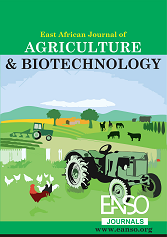Influence of Cultivars and Intra Row Spacing on Performance of Maize in Keiyo North Sub-County, Kenya
Abstract
Maize is a major crop grown in Kenya for human and animal feed. Its production is determined by farming practices such as plant population, climatic factors, pests, diseases and nutrition, among others. Farmers grow maize varieties and are subject to the same spacing, yet they have varying nutrient requirements, resulting in low yields. The objective of this study was to determine the effect of spacing and varieties on quality and yield of maize. A study was conducted between March to December 2019 at Bugar and Tambach in Keiyo North Sub-County, Kenya. The treatments were three plant spacing at 75 cm× 20 cm, 75 cm× 25 cm and 75 cm× 30 cm. The three maize varieties selected were Hybrid 614, Hybrid 624 and Hybrid 6218. A factorial experiment (3×3) in a Randomised Complete Block Design with three replicates was conducted in both sites. Data was collected on the number of cobs,1000 grain weight and yield per 90kg bag was recorded at the end of the experiment. Data was subjected to two-way analysis of variance and means were separated by Tukey’s Honest Significance test at p≤0.05 in GenStat 14th Version. Results showed that there was no significant difference in interaction between spacing and varieties in both sites. There was significant p≤0.05 difference on number of cobs in Bugar on spacing but not on variety. The 1000 grain weight was significantly p ≤0.05 different in Tambach for variety but not spacing. H624 under 75 cm×20 cm produced the highest number of cobs in Bugar, while H614 under 75 cm×20 cm was best in Tambach. In conclusion, farmers in Bugar should plant H624 under 75×25cm while those in Tambach should plant H614 under 75 × 30 cm for optimum yields. These should therefore be the recommended spacing for these hybrids in Bugar and Tambach, Elgeyo Marakwet
Downloads
References
Abdoulaye, T., Wossen, T., & Awotide, B. (2018). Impacts of improved maize varieties in Nigeria: ex-post assessment of productivity and welfare outcomes. Food security, 10, 369-379.
Bakala, J., Devi, S., Ankita, A., Sarao, P. S., & Kaur, P. (2023). A Review on Maize (Zea mays L.)- An Important Cereal Crop. International Journal of Current Microbiology and Applied Sciences, 12(1), 2567-2575.
Bänziger, M., Setimela, P. S., Hodson, D., & Vivek, B. (2006). Breeding for improved abiotic stress tolerance in maize adapted to southern Africa. Agricultural Water Management, 80(1-3), 212-224.
Bhatt, K. R., Bhattachan, B. K., Marahatta, S., & Adhikari, J. B. (2019). Yield performance of maize (Zea mays L.) under different cobinations of organic and inorganic nutrient management during spring at Rampur, Chitwan, Nepal. Acta Scientific Agriculture, 4(1), 120-127.
Blake, M. (2015). Maize for the Gods: Unearthing the 9,000-year History of Corn. Univ of California Press.
Choufani, J., El Ammari, N., Boutaleb, S., Mabrouki, Y., & Ziyad, M. (2017). Impact of Climate Change on Agricultural Yields in Morocco: An Econometric Analysis. Procedia Environmental Sciences, 37, 13-24.
Enujeke, E. C. (2013). Effects of Variety and Spacing on Growth Characters of Hybrid Maize. Asian Journal of Agriculture and Rural Development, 3 (5), 296-310.
Fanzo, J., McLaren, R., Davis, C., & Choufani, J. (2017). Climate change and variability.
Fischer, R. A., Ramos, O. M., Monasterio, I. O., & Sayre, K. D. (2019). Yield response to plant density, row spacing and raised beds in low latitude spring wheat with ample soil resources: an update. Field crops research, 232, 95-105.
Gebre, G. G., Isoda, H., Amekawa, Y., & Nomura, H. (2019, September). Gender differences in the adoption of agricultural technology: The case of improved maize varieties in southern Ethiopia. In Women's Studies International Forum (Vol. 76, p. 102264). Pergamon.
Headey, D. (2016). The evolution of global farming land: facts and interpretations.
Jirström, M., Andersson, A., & Djurfeldt, G. (2011). Smallholders caught in poverty— flickering signs in agricultural dynamism.In G. Djurfeldt, E. Aryeetey, & A. Isinika (Eds.), African smallholders: Food crops, markets and policy. CAB, 74– 106.
Leitner, S., Seijmonsbergen, A. C., Mucanje, P. J., & Jetten, V. (2020). Unraveling the drivers of maize yield gaps in sub-Saharan Africa. Global Food Security, 27, 100432
Lowder, S. K., Skoet, J., & Raney, T. (2016). The number, size, and distribution of farms, smallholder farms, and family farms worldwide. World Development, 87, 16–29.
Macauley, H., & Ramadjita, T. (2015). Cereal crops: Rice, maize, millet, sorghum, wheat.
Odeleye F. O., & Odeleye, M. O., 2001. Evaluation of morphological and agronomic characteristics of two exolic and two adapted varieties of tomato (Lycopersicom esculentum) in South West Nigeria. Proceedings of the 19th Annual Conference of HORTSON, (1), 140-145.
Sangoi, L., Almeida, M. L., Gracietti, M. A., & Bianchetti, C. (2002). Response of Brazilian maize hybrids from different eras to changes in plant density. Field Crops Research, 79(1), 39-51.
Shaka, A., Belete, K., Zeleke, H., & Ambo, E. (2019). Effects of inter-and intra-row spacing on growth, green cob number and biomass yield of maize (Zea mays L.) varieties at Agarfa, southeastern Ethiopia. Journal of Biology, Agriculture and Healthcare, 9(9), 36-46.
Tollenaar, M., & Lee, E. A. (2002). Yield potential, yield stability and stress tolerance in maize. Field Crops Research, 75(2-3), 161-169.
Toroitich, P. J., Kitainge, K., & Oseko, A. (2024). Evaluating the Effectiveness of Clinical Intervention Strategies for Addressing School Refusal Behavior Among Primary School Pupils in Keiyo North Sub-County, Elgeyo Marakwet County, Kenya. Journal of Research in Education and Technology, 2(2), 74-84.
Copyright (c) 2025 Ishmael Chesinen, Elmada Auma, PhD, Lucas Ngode, PhD

This work is licensed under a Creative Commons Attribution 4.0 International License.




























